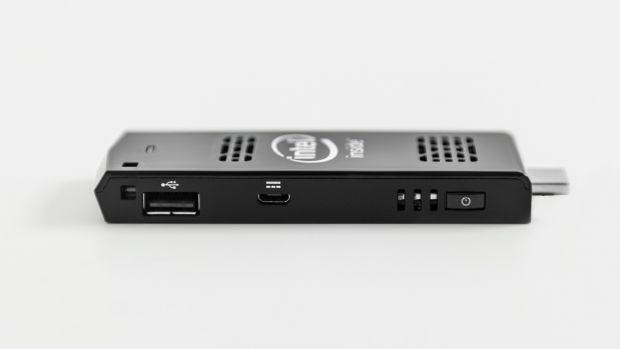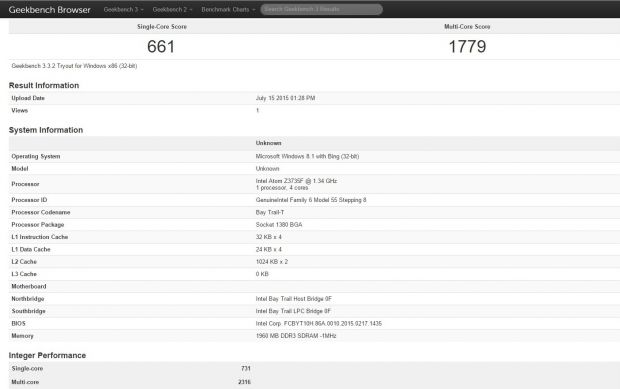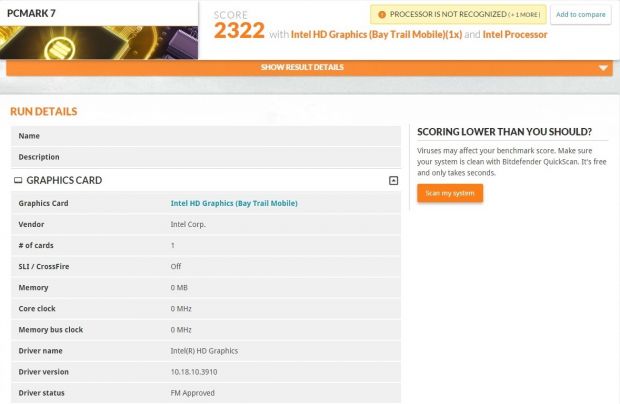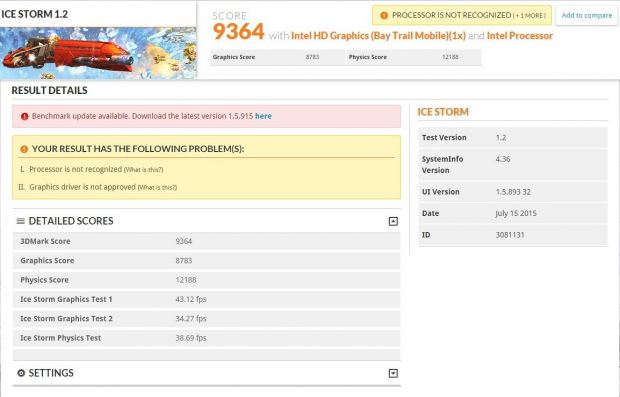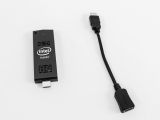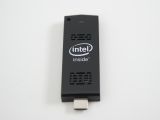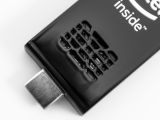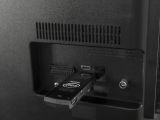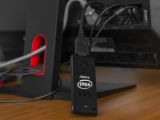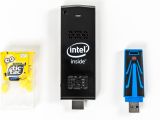The new portable PC from Intel is exactly what the name suggests, a computer in a stick just a bit larger than your average USB key that will turn any display screen equipped with an HDMI-in port into an on-spot PC.
In its current incarnation, the Intel Compute Stick functions more like a proof-of-concept, a prototype that impresses by its size and not by what it can do. It manages to cram inside mostly everything a PC needs and run the latest Windows version from Microsoft.
It can do that and a bit more: it lets you surf the Internet, use any Office tool flawlessly and watch movies in 720p resolution. Anything beyond that, it won’t do very well.
You have to keep in mind the specs it comes with, though. Working with a fan-cooled Intel Atom Z3735F CPU (2MB Cache, 1.33 GHz) and an Intel HD Graphics integrated GPU, the Compute Stick won’t do you any favors in most graphics-based applications. The single-channel 2GB DDR3L-R-S memory @ 1.35V, 1333 MHz will take you years back in terms of booting your system as well as during application loading times.
| Operating System | Windows 8.1 with Bing 32-bit Ubuntu (Linux) 14.04 LTS 64-bit |
|---|---|
| Processor | Fan-cooled Intel Atom Z3735F, 2MB Cache, 1.33 GHz |
| BIOS | FCBYT10H.86A.0018.2015.0330.1117 |
| Graphics | Intel HD Graphics |
| System Memory | Single Channel DDR3L-R-S memory @ 1.35V, 1333 MHz · Windows model: 2GB · Ubuntu model: 1GB |
| Storage | Built-in Samsung MGB4GC eMMC storage · Windows model - 32 GB Samsung · Ubuntu model - 8 GB SDXC v3.0 slot with UHS I-support |
| Peripherals | Integrated 802.11bgn Wi-Fi USB 2.0 Bluetooth 4.0 MicroSD card slot |
| Networking | Integrated 802.11bgn |
| Audio | Intel HD Audio via HDMI with multi-channel support |
| Power Requirements | 5V, 2A wall-mount AC-DC power adapter |
| Chassis Size | 103 mm x 37 mm x 12 mm |
One of its main drawbacks isn’t really the lack of performance but the disregard of basic ergonomics. While setting up what is essentially a mini-PC, one would grab a mouse and a keyboard and find a convenient port to plug them. And there is exactly one. One USB 2.0 port.
For all compatible peripherals a PC might need, there is a single USB port, and if you don’t have at least one Bluetooth mouse or keyboard, things get complicated.
Workarounds exist, however: plugging in your mouse offers a minimal degree of control and you can use the Windows virtual keyboard to click your way to the basic operating system settings. With that same mouse, you will be able to turn on your Bluetooth 4.0 Radio which, by the way, should be turned on by default, and connect whatever other Bluetooth peripherals you have at your disposal.
The most straightforward solution, albeit one that not all users will have at their disposal, is to plug a universal wireless keyboard & mouse dongle in that single USB port and be done with all this hassle for good.
External Features
The Intel Compute Stick’s most promising feature is its external looks and dimensions. It’s a 103mm x 37mm x 12mm (4 x 1.4 x 0.4 inch) stick from which an HDMI port protrudes and provides connectivity to your display of choice. Other than that, it has a Micro SD card slot that can conveniently be used as a storage extension and a microUSB power port in which you will plug the included 3-foot-long power cable. It also has a security notch and, evidently, the power button.
Inside the Compute Stick package, you can also find an 8-inch female-to-male HDMI extension cable that will allow you to plug the stick in harder-to-reach HDMI ports. A very useful addition in fact, as most of our HDMI ports simply didn’t have enough room around them to accommodate the device without blocking other ports.
Testing methodology
We tested the Intel Compute Stick on a Lenovo ThinkCentre E93z all-in-one PC with HDMI input as well as an LG-42LS3450 40-inch TV.
OS Performance First Impressions
Once you manage to boot your Compute Stick, you will be welcomed by Windows 8.1 with desktop items set to "large," the default Windows Theme, and standard 59Hz screen refresh rate running on your monitor’s native resolution. All that can be changed in the Display settings in your Control Panel, but a reboot may be required in order to enable all your new display settings.
Checking our system properties with CPU-Z, we could see that we were indeed running on a quad-core 1.33GHz Intel Atom CPU.
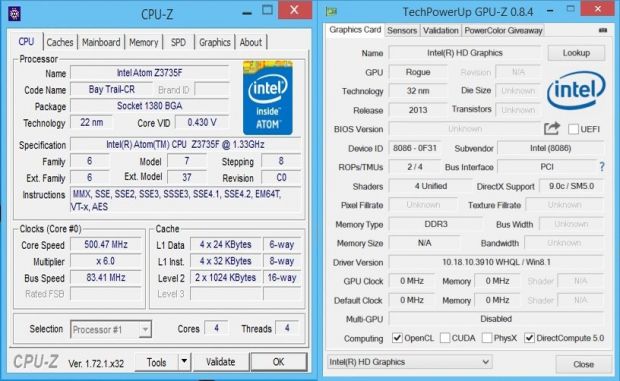 GPU-Z says this thing has a Rogue GPU" alt="The TechPowerUp GPU-Z says this thing has a Rogue GPU" />
GPU-Z says this thing has a Rogue GPU" alt="The TechPowerUp GPU-Z says this thing has a Rogue GPU" />Meddling around inside the Device Manager, we were surprised to see that the built-in 32GB flash memory is actually a Samsung MBG4GC module. If the 32GB storage space isn’t enough for you, the overall storage space can be extended through SDXC v3.0 slot on the side of the stick.
Our performance tests were carried out with Geekbench 3, PCMark 7 and 3Dmark 8 using its lightest benchmarking demo (Ice Storm).
Geekbench 3
Geekbench 3 is an easy-to-use exhaustive benchmarking piece of software dedicated to mobile platforms that use less powerful CPUs than their larger desktop brothers. Geek bench 3 tested both single-core and multi-core threads in order to get a more accurate assessment.
As you can see, the results are unconvincing, as the Compute Stick offers multi-core performance close to other Atom tablets, only being stronger than some Celerons and other older Atom CPUs.
PCMark 7
PCMark 7 from Futuremark is a comprehensive benchmarking software meant to assess your overall PC performance and compare it in general terms with an internal database of similar PCs in order to help you make an idea where your hardware stands in an overall trend.
The PCMark score rating was 2322, pretty low as the average scores go up in the tens of thousands. However, as the Intel Atom is a mobile dedicated CPU, PCMark 7 had issues recognizing it. Overall, this is a clear message that you’ll never be able to play Battlefield 4 on this fragile stick, to say the least.
3Dmark 8
3DMark is a renowned GPU benchmarking piece of software. It’s the top-of-the-line performance assessing software when it comes to stress-testing the most advanced graphics cards on the market with its 4K physics and shading demos. However, it also comes with benchmarking demos dedicated to mobile graphics solutions, and the Intel HD Graphics integrated GPU did a decent job there.
Although it had a very low score compared to the other 95% of tested GPUs, it did pull off a playable 34 to 43 fps in the Ice Storm benchmark demo, achieving the absolute bare minimum when it comes to graphical performance. That being said, this is not a gaming friendly device, not by a long-shot.
When it comes to Internet browsing, we discovered that it can run full HD movies in a decent manner with only small lag spikes while going from compact mode to full screen.
The wireless Azurewave AW-NB177NF M.2 module shares the load for both Wi-Fi connections and Bluetooth 4.0 connectivity. The device is a single-band 802.11 b/g/n that runs in the 2.4 GHz range. If it has to provide both sorts of connectivity at the same time, it will drop browsing performance dramatically causing streamed HD videos to lag and stutter, while basic web pages will take a long time to load. This issue can be eliminated by disabling Bluetooth.
The Wi-Fi module is only rated to run at 150Mbps, despite that we only managed to get 1.5Mbps transfer speeds while connected to our LAN. More than that, any sort of bandwidth usage dropped our download speeds to abysmal 300kbps speeds
The Good
It feels like this is a product made by Intel to test the market. It isn’t as compact as some would expect and similar to a prototype, neither very ergonomic. It’s a proof of concept made to prepare the public for more advanced, more compact and maybe even more peripheral-friendly devices that will arrive from Intel later on.
Intel is also validating the Compute Stick for a Windows 10 upgrade. Drivers are expected to be available by July 2015.
The Bad
The very low graphics performance of this device, unfortunately, won’t recommend it to users who want to enjoy games or HD media, even less so when it comes to 4K videos.
Conclusion
Right now, however, it has little applicability except for browsing websites with a bare minimum of performance and some office work. To compare this design with the likes of Google Chromecast, the Intel Compute Stick does less of everything, while those do just one specific job, but much better.
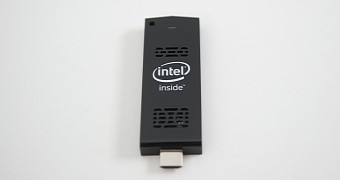
 14 DAY TRIAL //
14 DAY TRIAL // 